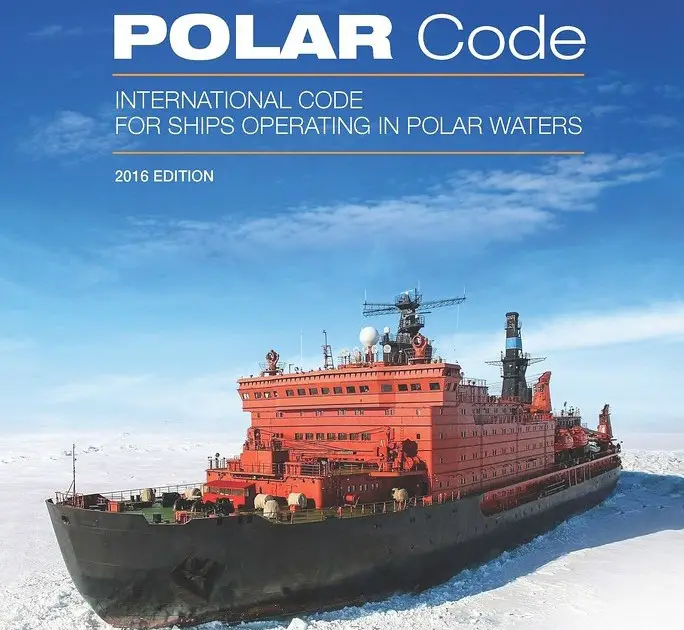The International Maritime Organization (IMO) has adopted the international code for ships operating in polar waters (Polar Code), and related amendments to the international convention for the safety of life at sea (SOLAS) chapter XIV “Safety Measures for ships operating in polar water” to make it mandatory, because it contains both safety and environment-related provisions, the polar code will mandatory under both SOLAS and the international convention for the prevention of pollution from ships (MARPOL)
the code entry into force of the SOLAS amendments is 1st January 2017. The Polar Code highlights the potential hazards of operating in polar regions, including ice, remoteness, and rapidly changing and severe weather conditions, and provide goals and functional requirements in relation to ship design and construction, equipment, operations, training, and search and rescue, relevant to ships operating in arctic and antarctic waters.
The code required a polar water operational manual (PWOM), to provide the owner, operator, master, and crew with sufficient information regarding the ship’s operational capabilities and limitations in order to support their decision-making process.
Contents of Polar Code
PART I -A- Safety Measures
Chapter 1: General
Chapter 2: polar water operational manual
Chapter 3: Ship structure
Chapter 4: Subdivision and stability
Chapter 5: Watertight & Weathertight Integrity
Chapter 6: Machinery Installation
Chapter 7: Fire & Safety Protection
Chapter 8: Life-Saving Appliances
Chapter 9: Safety Of navigation
Chapter 10: Communication
Chapter 11: Voyage Planning
Chapter 12: Manning
PART I-B- Additional Guidance
PART -II: Pollution prevention measure
Chapter 1: Marpol Annex I
Chapter 2: Marpol Annex II
Chapter 3: Marpol Annex III
Chapter 4: Marpol Annex IV
Chapter 5: Marpol Annex V
PART II-B- Additional Guidance
The Goal of the Polar Code
The goal of the polar code is to provide safe operation and the protection of the polar environment by addressing risks present in polar waters and not adequately mitigated by other instruments of the organization.
Source of Hazards
- ICE : it affects hull structure stablity Naviagtion,outdoor working envirment, manitennace and emergency preparedness.
- Low Temprature
- Extended period of darkness and daylight
- Remotness : possible lack of hydrographic data & information, limited SAR facilities
- Rapidly changing and severe weather conditons
- Potential lack of ship’s crew experience in polar operation
- Environment impact in relation to harmful substance.
Instrument to Mitigate these Hazards
- Polar water Operational Mannuual (PWOM)
- Additional structure Requirments
- Additional Subdivisional & Stablity Requirments
- Additional LSA & FFE Arragements
- Safety Of naviagtion- To provide safe navigation by sea for additional Nav Equipments
- Machinary Installation- Capable & safe Operation
- Communicatuion- By providing additional communication equipments
- Voyage planning
Certificate :
- Every Ship to which this code applies shall have onboard a valid POLAR SHIP CERTIFICATE
- Polar ship certificate issued by the administration or an organisation recognised by the administration in accordance with SOLAS CH-XIV & MARPOL.
Polar Water Operational Manual (PWOM)
The Polar water manual shall include or refer to specific risks on board and procedures to be followed. in normal operation and in order to avoid encountering conditions that exceed ship capabilities.
Procedure to be followed in the event of incidents in polar water
Procedure to be followed in the event that conditions are encountered which exceeds the ship specific capabilities and limitations
procedure to be followed when using ice breaker assistance
Types of Ships as per POLAR CODE
- Category A : A ship Design for operating in polar waters in atleast medium first year ice which inculde old ice inclusion.
- Category B : A Ship not included in category A designed for operation in polar water in atleast thin first year ice,which may include old ice inclusions.
- Categroy C : A Ship designed to operate in open water or in ice conditions less severe than those inculded in category A and B
Navigation Equipment Required as per POLAR CODE
- Two Non Magnetic Compass, means to determin and display headings.both shall be independent and shall be connected to the ships main and emergency source of power.
- Ship proceeding to lattitude over 80 DEG. shall be fitted with atleast one GNSS compass or equivalent.
- Ship with exemption of those solely operation in areas with 24 hrs daylight shall be equiped with two remotely rotatable narrow beam search light controlled from bridge to provide lighting area an arc of 360 DEG or other means to vissualy detect ice .
- A Weather Facsimile receiver and spare antenna for receiving and displaying current information on ice conditions in the area of operation
- Two independent echo sounding device or one echo sounder with two seperate independent transducers.
- Menas to prevent accoumlation of ice on antennas required for Ice Navigation and communication
- Ships involved in operation with ice breaker escort,shall have mannually initiated flashing red light visible from astern to indicate when the ship is stopped . range of light atleast 2 NM
- Two Radars
- A clear view Screen
I hope you like the information and if anything we miss. Please let us know in the comments section. we love to hear from our readers.





PWOM